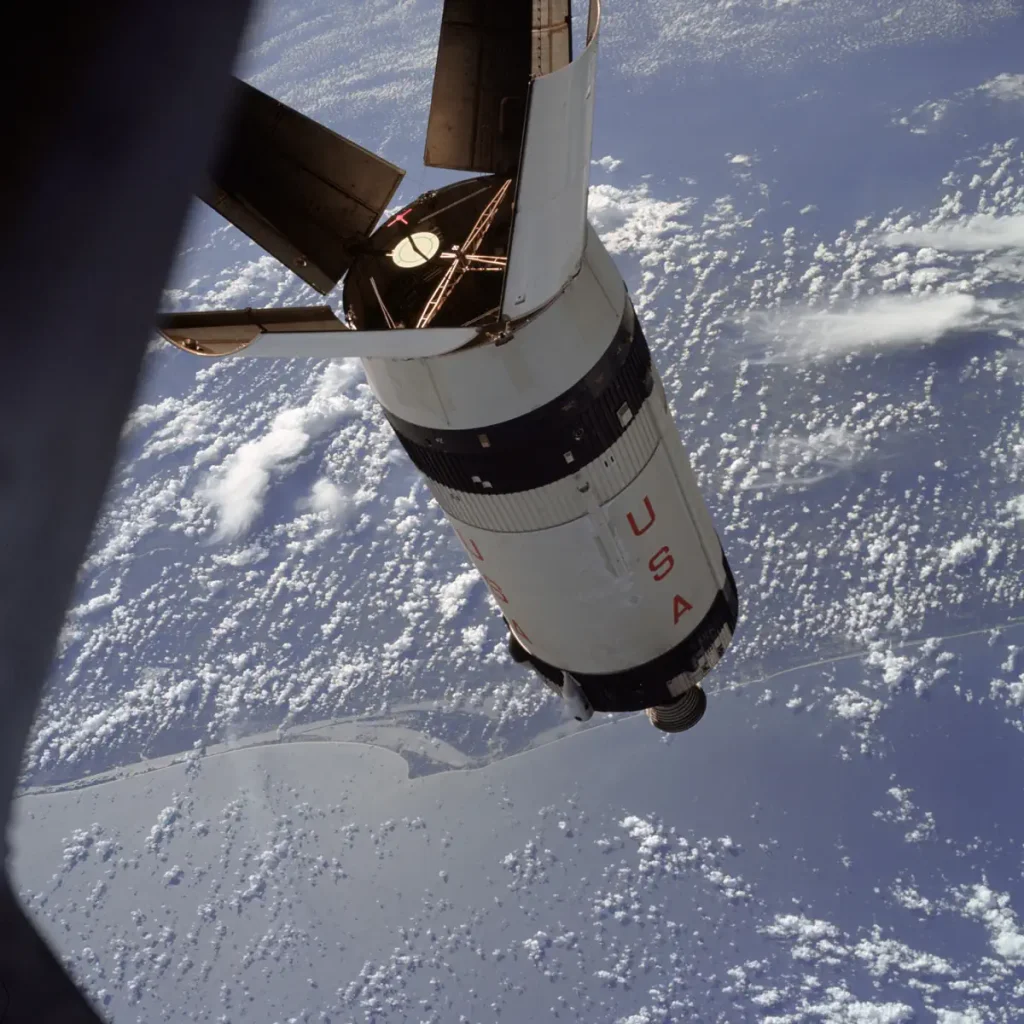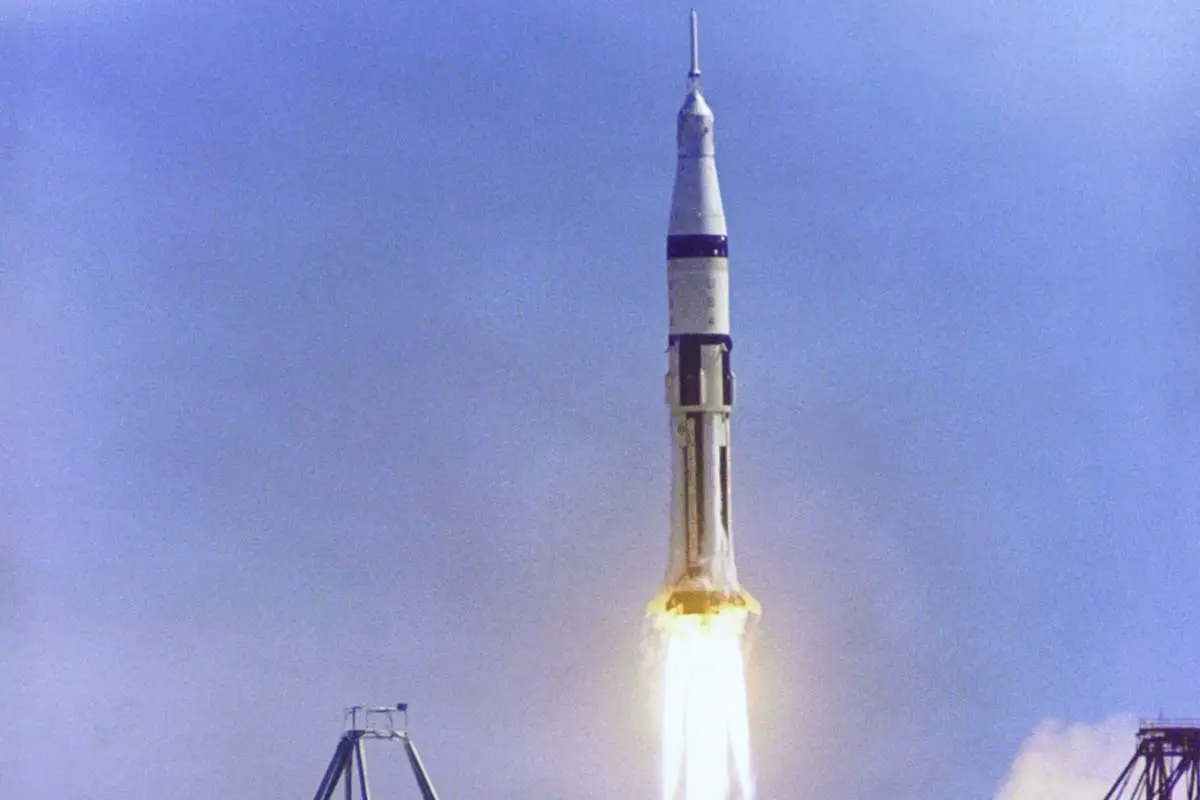Apollo 7, the first crewed flight in NASA’s Apollo program was launched on October 11, 1968, exactly ten years after the space agency’s first launch. The mission successfully demonstrated the crewed performance of the Command and Service Modules and featured the first American live broadcast from space.
Today’s (October 11) story of what happened this day in Science, Technology, Astronomy, and Space Exploration history.
Apollo 7
United States crewed space program was halted after the fire that killed the three Apollo 1 astronauts, Gus Grissom, Ed White, and Roger Chaffee, during a launch rehearsal test on January 27, 1967. This incident caused almost two years of Apollo spacecraft redesign and testing.
So, launched on October 11, 1968, Apollo 7 saw the resumption of U. S. human spaceflight. The three crewmembers were:
- Walter M. Schirra (March 12, 1923 – May 3, 2007), commander
- Donn F. Eisele (June 23, 1930 – December 2, 1987), Command Module (CM) pilot
- R. Walter Cunningham (born March 16, 1932), Lunar Module (LM) pilot. Apollo 7 did not carry a Lunar Module, because it didn’t landed on the moon, but he was designated so despite this.

Apollo 7 was the first crewed mission of the spacecraft designed to meet President John F. Kennedy’s challenge in 1961 to put an American stronaut on the lunar surface. But, the spacecraft didn’t leave the Earth orbit. The first spacecraft to do so was Apollo 8.
The primary objectives of the mission were:
- Demonstrating Command and Service Module (CSM), crew, launch vehicle, and mission support facilities performance
- Demonstrating CSM rendezvous capability.
- Two photographic experiments and three medical experiments were also planned.
Apollo 7 also saw the first live TV broadcast of Americans from space.

Following a flawless liftoff atop a Saturn 1B rocket from Launch Complex 34 at Cape Kennedy (now Cape Canaveral) Air Force Station, the S-IVB/CSM was put into a 228 x 282 km (142 x 175 miles) Earth orbit.
Venting of S-IVB propellants raised the orbit to 232 x 309 km (144 x 192 miles) over the next three hours, at which time the S-IVB stage was separated from the Command Service Module (CSM). The S-IVB stage was then used for rendezvous maneuvers over the next two days.
Command Module pilot Eisele then practiced a simulated Lunar Module (LM) docking.
A key objective of Apollo 7 was testing spacecraft systems, especially the crucial service propulsion system (SPS) engine at the base of the spacecraft. On lunar missions, the SPS would be used to place the spacecraft in lunar orbit and later, fire the crew on a trajectory back home. On Earth orbital flights, the SPS would be fired to slow Apollo for reentry.
The first test of the powerful SPS took place on flight day two. When it fired with 20,500 pounds of thrust, Schirra, the mission’s commander radioed that it was a real kick.
Another mission goal was broadcasting live television from the spacecraft. Three days after liftoff, the Apollo 7 camera was turned on, allowing Mission Control and viewers around the world to watch the crew in orbit.

Photo caption on the NASA Moon website: The expended Saturn S-IVB stage as photographed from the Apollo 7 spacecraft during transposition and docking maneuvers at an approximate altitude of 125 nautical miles (231.5 km / 144 miles), at ground elapsed time of three hours and 16 minutes (beginning of third revolution). This view is over the Atlantic Ocean off the coast of Cape Kennedy, Florida. The Florida coastline from Flagler Beach southward to Vero Beach is clearly visible in picture. Much of the Florida peninsula can be seen. Behind the open panels is the Gulf of Mexico. Distance between the Apollo 7 spacecraft and the S-IVB is approximately 100 feet (30.5 meters). The round, white disc inside the open panels of the S-IVB is a simulated docking target similar to that used on the Lunar Module (LM) for docking during lunar missions.
Crew got sick
Shortly after liftoff, the missioncommander, Schirra, reported he was developing a bad head cold.
The next day the other two crew members too reported symptoms.
The microgravity environment exacerbated the cold conditions because normal drainage of fluids from the head did not occur.
Astronauts took medications, but the colds caused extreme discomfort to the crew throughout the mission. This hampered performance of some of the scheduled duties.
During re-entry, the astronauts did not wear their helmets to make it possible to properly clear their throats and ears.
Splashdown
Apollo 7 spacecraft splashed down in the Atlantic Ocean on 22 October 1968 after a mission elapsed time of 260 hours, 9 minutes, and 3 seconds.
The Apollo 7 mission was successful in every respect. All spacecraft systems operated satisfactorily, and all but one of the detailed test objectives were met.
As an engineering test flight, Apollo 7 demonstrated the performance of the orbital safing experiment, the adequacy of attitude control in both the manual and automatic modes, and that the vehicle systems could perform for extended periods in orbit. For the first time, a mixed cabin atmosphere consisting of 65 percent oxygen and 35 percent nitrogen was used aboard an American piloted spacecraft.
All previous flights had used 100 percent oxygen, a procedure changed as a result of recommendations made by the Apollo 1 fire investigation board.
Another “first” was the availability of hot and cold drinking water for the crew as a by-product of the service module fuel cells, an important element for piloted lunar excursions. Consumables usage was maintained at safe levels, and permitted the introduction of additional flight activities toward the end of the mission.
October 11 in Science, Technology, Astronomy, and Space Exploration history
- 1968: Apollo 7 was launched.
- 1958: NASA’s first launch: Pioneer 1
Sources
- Apollo 7 Ends, “101% Successful” on the NASA website
- “Apollo 7 – The First Mission: Testing the CSM in Earth Orbit. 1 October-22 October 1968” on the NASA History website
- Apollo 7 Press Kit [pdf] on the NASA website
- Apollo 7 on the NASA Space Data Coordinated Archive website
- “About Apollo 7, the First Crewed Apollo Space Mission” on the NASA website
- “Apollo 7 Launched as Race to Moon Reached Final Stretch” on the NASA website
- Moon Landings: All-Time List [1966-2025] - February 2, 2025
- What Is Max-Q and Why Is It Important During Rocket Launches? - January 16, 2025
- Top 10 Tallest Rockets Ever Launched [2025 Update] - January 16, 2025
